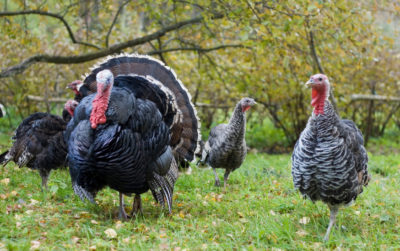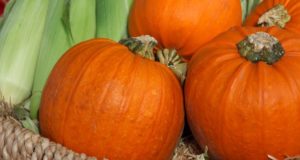One of the greatest things about homesteading is the limitless variety of projects you can try on for size. Unfortunately, this can also be one of the most frustrating aspects of homesteading. Staying focused and not spreading yourself too thin can be as challenging, at least as challenging as working through the projects you already have on the table. With this in mind, it is nice when you are adding new elements to your operation to find new endeavors that utilize and build upon existing knowledge, skill sets, and infrastructure rather than starting from scratch with every new addition. Many times you will find yourself cast into the wilderness with a new addition, so the times when you find a new project that uses the same or similar skills and can borrow from existing infrastructure, well, they’re like a gift from heaven. But remember what the wise men once said: never look a gift horse in the mouth.
For us, raising turkeys has been one such gift horse. It is proving to be very rewarding, has borrowed skills and facilities from previous and ongoing projects, and has been wrought with occasional frustrations and setbacks. In other words, an incredibly exhilarating homesteader’s experience!
If chickens are already a part of your homestead, you have probably developed all the skills you need to raise turkeys. Furthermore, you probably have all the supplies and equipment needed and can easily re-task portions of your chicken infrastructure to turkeys with very little trouble. All you need is a place to brood your turkey poults and a place to finish raising them once the brooding process is complete. Feeders, waterers, and heat sources can all be borrowed from an existing chicken operation. Dual tasking of this equipment adds to its value, and helps you get more bang for your buck. If you do not already have this equipment, it is relatively cheap and easy to get, and acquiring it will put you in position to add chickens to your homestead in the future.
Brooding is perhaps the most critical aspect of raising turkeys, even more so than with chickens. Turkey poults are very susceptible to cool or damp conditions. Despite their larger size, they succumb to fluctuations in these environmental conditions more rapidly than chicks, and therefore controlling these conditions is of utmost importance. On our first run of turkeys, I made a critical mistake in my watering strategy. I assumed that larger birds needed a larger waterer. Bad move. I went out to the brooder that first morning to find almost half of my thirty poults soaked and in various stages of near death.
Successfully Raise Farm Animals With The Backyard Homestead Guide…
Emergency procedures were quickly improvised. The wet birds were brought into the house, a box with a heat lamp was set up in the dining room, and my wife, five kids and I spent the next couple hours with towels drying, rubbing and reviving the hapless turkeys. In the end we saved them all, but it was touch and go, and a good lesson learned. With turkey poults, use the small chick waterers, provide extras, and check them more often to make up for the turkey’s larger size. For the same reasons, it is important to add fresh dry bedding. We use straw for this purpose, but wood chips or shavings are a good option too. Shredded paper gets too soggy, so unless you want to change bedding every day, it should be avoided.
Crowding is another critical point with turkey poults. It is important not only to provide them with enough space, but also with enough heated space. If there is not enough room under the heat lamp, they will crowd and pile up, which can lead to crushed and smothered poults at the bottom of the pile. Our turkey brooder is a re-tasked 4 x 8 rabbit hutch, plywood on three sides, and one-inch hardware cloth on the front. In this space we brood 30 or so poults at a time. We provide two heat lamps, one in each corner of one end. This gives them enough heated space to spread out, avoiding piling on.
Turkeys require more time in the brooder than chickens. Where chicks will spend two weeks in the brooder, turkeys need six or seven. Despite their larger size, the turkey has a longer fragile period. Once again, you can learn from my mistakes and not rush this process. On our first run (these poor turkeys took a beating along the slope of my learning curve!), I moved them into a pen on pasture about two weeks too soon. I was fooled by their size and apparent robust nature after about five weeks in the brooder and moved them out. Their first night on pasture, it rained heavily. Even though the pen was tarped, nine of my young turkeys were soaked in the morning and back into a state of shivering and half dead. Previously established emergency procedures were implemented. Out came the towels, and my now experienced crew of turkey medics went to work. Once again, all birds were saved, but I suspect a bit of divine providence rather than my exemplary turkey raising skills can be thanked for that!
A couple of last notes on the early life of turkeys. Sometimes, turkey poults need to be taught how to feed. For this reason, it is a good idea to brood a couple of chicks along with your turkeys. We often use guineas for this purpose. Guineas are natural born hunters and foragers, and although turkeys need a bit of instruction, they are good learners given the right instructors. As for feed, we use the same GMO-free broiler feed that we use for Cornish cross meat chickens. Some sources will tell you that turkeys require a bit higher protein, but you can supplement standard chicken feeds with a few hard-boiled eggs to make up the difference.
Once you have made it through the brooding stage, you can move your turkeys into a yard or pen. We like to raise all our stock on pasture if possible. We make the first move for our turkeys a trip to a 10 x twelve “chicken tractor” where we house them for an additional month. The tractor is moved at least once a day to provide fresh forage. Turkeys are awesome foragers. Once you get your birds out of the brooder, you will find that their feed requirements are much less than chickens, as long as you provide them with adequate pasture. After a month in the tractor, we move the turkeys into our orchard, where they are housed at night in a stationary version of the 10 x 12 tractors. During the day, they are turned out in the orchard to graze (another great feature of the turkey!) and forage. We continue to supplement with broiler feed and scratch grains as needed. Fifty turkeys in the orchard have virtually eliminated the need to mow that space, and dramatically reduced the number of insect pests.
If you don’t want the added expense and work of the “turkey tractors” or if you lack pasture, turkeys can be kept like a flock of chickens. They require a place to shelter and roost at night, like a chicken coop, and beyond that they can be treated like any other yard bird. Provide feeders and waterers and let them go. Off pasture, obviously, they will require more feed. They can also be grown out in pens, again more feed intensive than pasture but acceptable. Remember though, the more space restricted your flock is, the more closely you will have to monitor their health. With pasture techniques, both our chickens and our turkeys have been completely disease-free. This has removed the burden of having to decide if antibiotics are an acceptable practice. In our opinion, antibiotics are only acceptable in very extreme cases and hormones in feed are never acceptable.
The biggest decision you will have to make is what kind of turkeys to raise. You have several options, none bad. For fast growth and an end result that most closely resembles a grocery store turkey, you can go with a modern production breed such as the White or Bronze broad-breasted. We raise some Whites and have been very happy with the results. There are also many heritage breeds available. Heritage breeds are better foragers, hardier, and raising them helps preserve a rich and diverse livestock history. Bear in mind that the heritage breeds are more like a wild turkey than a production turkey in terms of conformation: they will be leaner and the bulk of the meat will be in the breasts. Heritage breeds are rewarding. They are quite palatable and keep us close to our farming traditions.
Turkeys are a great addition to any homestead. They can be raised with previously developed skills and infrastructure. They are a great source of food for your family. Best of all, selling a big batch of thanksgiving turkeys can fund your Christmas shopping!
 Off The Grid News Better Ideas For Off The Grid Living
Off The Grid News Better Ideas For Off The Grid Living





